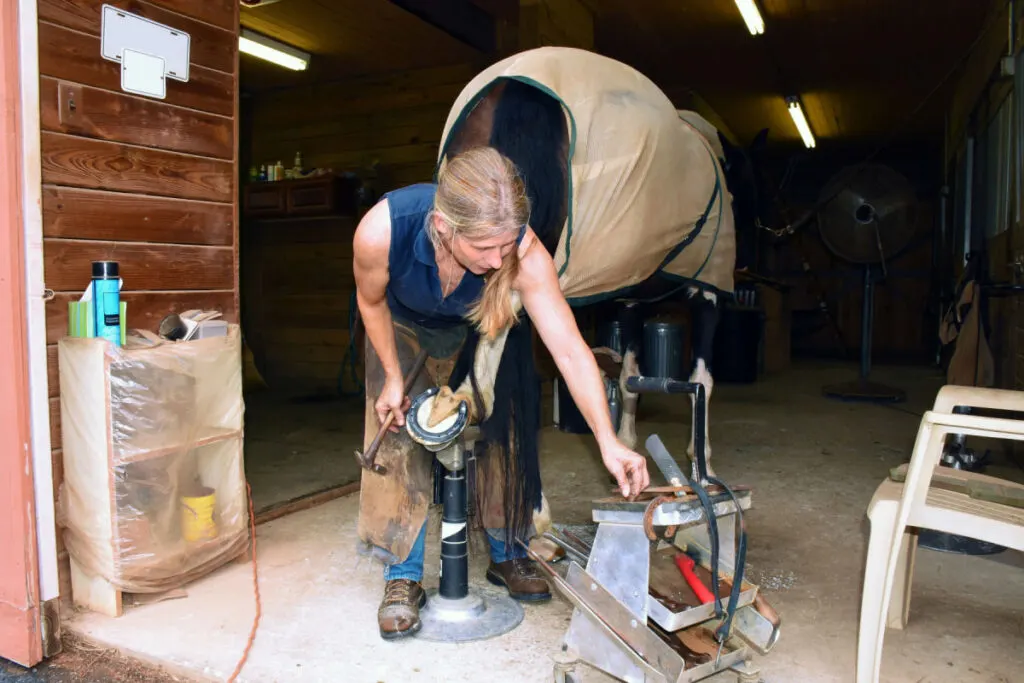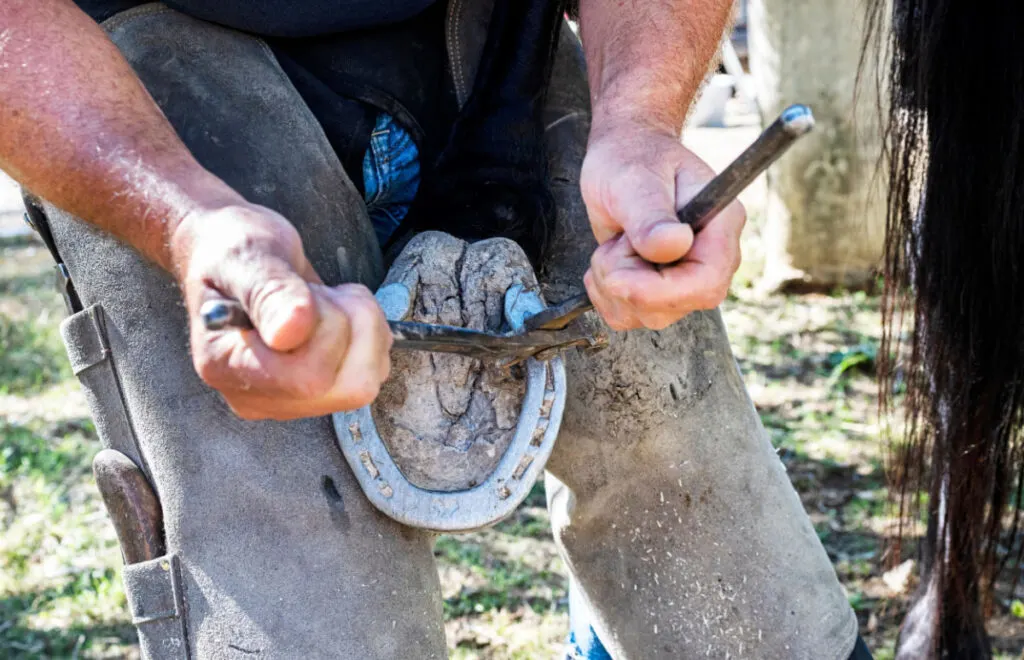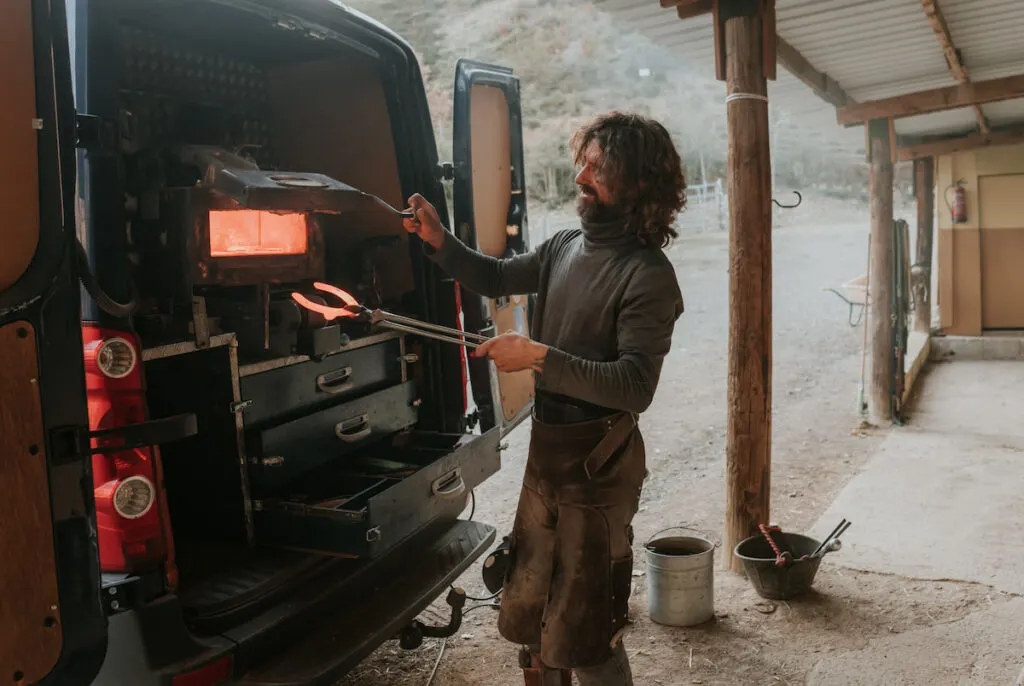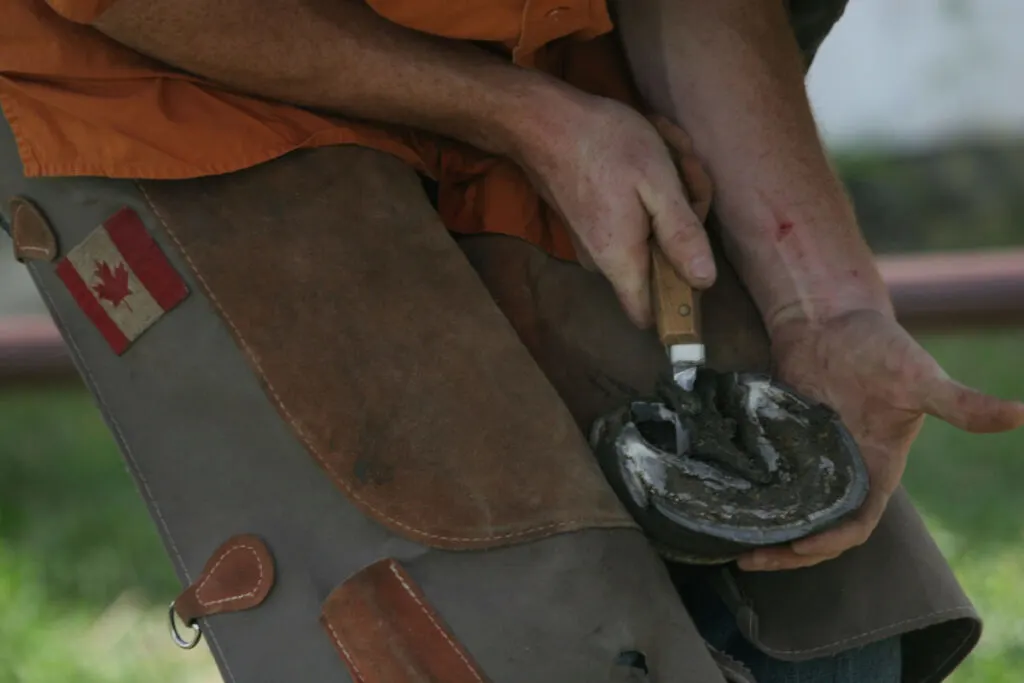While the average wage for a typical farrier is between $41,000 and $56,000 a year (depending on your state), many factors can affect this number.
If you’re interested in becoming a farrier, here are all the different costs and benefits that you should consider before getting to work. (source)
Table of Contents
What is a farrier?

A horse’s hooves grow continuously throughout its lifetime. Wild horses file their hooves naturally on hard, rocky ground, but most domesticated horses require a foot trim every six to eight weeks.
Many horses also require form-fitting metal shoes to help their hooves stay healthy.
A farrier is “a craftsman who trims and shoes horses’ hooves.” They clean, trim, and shoe equine animals such as horses, donkeys, mules, or ponies. General riding horses need hoof trims every 6-8 weeks, and most horse owners should factor farrier costs into their monthly equestrian budget.
Average Cost Breakdown for Farrier Services
Farrier Ray Legel describes his experiences like this:
Let’s say a farrier charges $22 for a standard hoof trim with a $12 travel fee. If they can trim 3 horses in an hour, that’s $78 per hour. Subtracting all of the extra overhead costs leaves them with about $42 per hour.
Then, once accounting for taxes, they are left with around $30 per hour, but this doesn’t include travel time to and from the barn, or any extra services. (source)
An efficient and skilled pleasure horse farrier can therefore expect to take home between $15 and $50 per hour, depending on travel time and amount of clients.
Different Types of Farriers
Most farriers are self-employed, and must build a client base to be successful. Some farriers choose to work part-time and have other streams of employment on the side.
Due to the nature of the work, most self-employed farriers travel to see their clients at their home stables. However, some large-scale equine operations may have their own dedicated in-house farriers, especially racing or breeding farms.
Other farriers specialize in making custom shoes or prosthetics for horses with special hoof needs. Or, they may serve as educators, speaking at clinics or taking on apprentices.
Here are some other specialties that a farrier may practice instead or in addition to standard farriery.

- Natural hoof care. Focuses on trimming a horse’s feet in a way that is consistent with natural methods a horse may experience in the wild.
- Show Horse or Track Farrier. Farriers that supply services to professional show horse barns can often charge much more than they would for a standard pleasure horse trim. Elite competition horses may have complicated shoeing needs, and their success depends on having healthy feet.
- Corrective or Therapeutic Specialist. A farrier who specializes in corrective shoeing to correct conformational faults or help heal injuries.
- Veterinary Farrier. Farriers may be trained in veterinary medicine to assist in a clinic or other veterinary capacity.
- Blacksmith. Blacksmiths are ironworkers, and can make and shape shoes and other products for their equine clients. Some farriers are blacksmiths as well, but not all blacksmiths are farriers.
Generally speaking, the more skills a farrier has and the more highly specialized the craft, the more money they can make – as long as there is a need for those skills and an opportunity to practice them.
According to this article from thefarrierguide.com, a show horse or track farrier can earn more than $100,000 or more per year – nearly double the wage of the average pleasure horse farrier.
Training and Education
Becoming a farrier generally requires a high school diploma and an apprenticeship. Farriers are not legally required to be licensed to practice in the United States, but there are four organizations that provide certifications for farriers:
- American Farrier’s Association
- Guild of Professional Farriers
- Brotherhood of Working Farriers
- Equine Lameness Prevention Organization
Though participating in these organizations may have associated costs, these organizations can also provide discounts on inventory supplies, insurance, or help defray other industry-related costs.
Each of these organizations has different costs and requirements for certification, but continuing education is an important part of a farrier’s practice. Plus, having a certification can help secure new clients.
Farrier School
Attending a school for farriers can be a good way to learn the ropes in a structured environment, but the tuition costs of individual programs can vary.
As an example, the E.L.P.O. Farrier School in Colorado costs between $6,500 and $8,900 for an intensive 8-week course.
If you’re serious about becoming a farrier, having a formal education in some of the techniques can help you secure an apprenticeship (or it may be enough training to begin your own practice right away).
Overhead Costs
Farriers are often self-employed small business owners who must travel for their work.
Many farriers set their own pricing, and they must account for their skills, time, geographical location, customer base, and overhead costs.
All of these things will factor into the final take-home salary of a farrier, who also doesn’t have guaranteed time off, vacation, sick days, or any of the other perks of a traditional 9-5 employee.
Typical overhead costs for a self-employed farrier include:
Vehicle Costs
Initial startup costs may include the purchase of a new vehicle and associated taxes. Because farriers must often drive to their clients instead of the other way around, they’ll have to pay for gas, maintenance, and insurance as costs of doing business.

Insurance Policies
Because farriers are generally self-employed, they are responsible for paying for their own health insurance. Working with large animals every day is difficult, physical, and downright dangerous at times.
Farriers should also carry life and disability insurance policies, just in case. The costs for these things can really add up, and take a large chunk out of the farrier’s overhead.
Anyone who works around large animals for a living should consider good health insurance!
Farrier Equipment and Tools
A startup package of farrier tools and equipment can run upwards of $1,700 (or more). These include things like protective gear, hammers, rasps, nail pullers, hoof picks, and other special equipment.
A gas-powered forge can cost anywhere from $500 – $50,000!
Inventory
A good farrier will have an inventory of common items that his clients may need. Having a variety of different-sized horseshoes, nails, and pads can save valuable time and money in the long run.
A single horseshoe can run between $10 and $200. While these costs are often deferred to the customer, a farrier may still need to have some on hand as well.
Taxes
Self-employment taxes can cost 30% or more of a farrier’s income, and they must pay state and federal taxes every year.
Miscellaneous Office Costs
Running your own business requires the use of a phone, internet, computer, printer, or other miscellaneous office supplies. Those costs can add up (although they are often tax-deductible).
Employees

Sometimes farriers will employ assistants or office staff to help them with their business. While working alone can help cut costs, it also means they have to do all the office work and the physical work themselves.
Continuing Education
Farriers should occasionally take classes or attend workshops to improve their skills. They may also have to pay dues to any farrier organizations they belong to.
Retirement and Savings.
Most traditional employers will offer an opportunity for a retirement account, but self-employed farriers may have to save for retirement on their own.
Is becoming a farrier right for you?
If you live in horse country with a large demand for hoof care, becoming a farrier can be the right career move. Horses need their feet serviced every 6-8 weeks, and a steady rotation of clients can be enough to support a small-scale independent farrier full time.
There are also positions for full-time farrier work at larger scale operations, which can be a great way to hone your craft in a specific setting.
If you like working with horses on a daily basis, and you’re interested in becoming your own boss – becoming a farrier could be right for you.
Sources:
- https://www.agcareers.com/career-profiles/farrier.cfm
- https://www.thebalancecareers.com/what-is-a-farrier-125615
- https://thefarrierguide.com/employment-guide/how-much-do-you-really-make/
- https://thefarrierguide.com/employment-guide/average-farrier-salary-wages/

